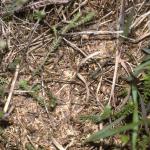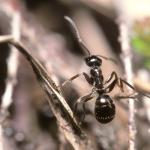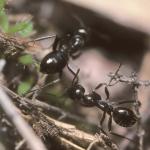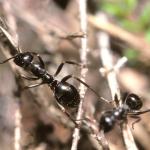This species was formerly recorded as Formica candida Smith, 1878 or Formica transkaucasica Nasonov, 1889. It is in a group of darker, more slender and agile species (the Serviformica) which includes the similar black species, F. fusca and F. lemani. Formica picea can be distinguished by its characteristic pilosity and shiny cuticle.
Formica picea has a localised distribution in England and South Wales. It is currently found on a small number of wet low land heaths in Dorset and Hampshire (particularly around Wareham and the New Forest), suitable habitat in Surrey and on lowland raised bogs near Carmarthen and on the Gower (Rhossili Down). The Welsh sites came to light in 1992 and 1996 respectively, the Surrey sites in 2003, and these significantly extend the known range of the species (an earlier unsubstantiated record for Rhossili from 1913 now seems likely to have been accurate). The similarity between F. picea and other 'Serviformica', along with its habit of living in the most inaccessible and wettest bogs may have led to under-recording. Overseas, found from Arctic Sweden and Siberia south to northern Spain, the Appenines, Caucasus and Himalayas, and east to Japan.
Formica picea is currently listed as Endangered RDB1 (Shirt, 1987) in Britain and has disappeared from several of its former sites. A Species Action Plan has been published (Anon, 1995) to assist with its conservation.
Associated almost exclusively with bogs and similar wet habitats in Britain.
Winged gynes and males are usually found in nests during July and August. Their flights have rarely been recorded and are likely to he inconspicuous with sexuals leaving nests sporadically.
The superficial nest structure comprising grass and moss fragments is usually built around a supportive grass tussock (often purple moor grass) or amongst clumps of moss. The nest may extend below ground or water level and workers will often disappear, dragging their brood below the surface if the nest is disturbed. At particularly suitable sites many nests may be found in close proximity to each other (although these do not necessarily represent individual colonies). Nests are usually found in the wettest parts of a bog and there are references to populations declining due to drought or other influences on the water level. Colonies are small in comparison with other Formica and have only one or very few queens.
Workers tend to forage singly and have been found tending Homoptera on young trees and shrubs or carrying dead invertebrates at some distance (5-10 m) from their nest. Foraging also seems to occur close to, or inside, the nest itself, as ant-tended coccids have been found feeding on grass stems within the nest structure.
In Britain no parasitic ants are known to be associated with F. picea, although it may occasionally act as host for temporary social parasitism by F. sanguinea queens.
2021





